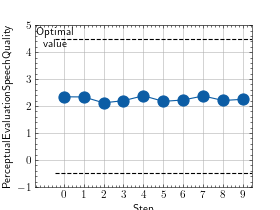Mean Intersection over Union (mIoU)¶
Module Interface¶
- class torchmetrics.segmentation.MeanIoU(num_classes=None, include_background=True, per_class=False, input_format='one-hot', **kwargs)[source]¶
Computes Mean Intersection over Union (mIoU) for semantic segmentation.
The metric is defined by the overlap between the predicted segmentation and the ground truth, divided by the total area covered by the union of the two. The metric can be computed for each class separately or for all classes at once. The metric is optimal at a value of 1 and worst at a value of 0, -1 is returned if class is completely absent both from prediction and the ground truth labels.
As input to
forwardandupdatethe metric accepts the following input:preds(Tensor): An one-hot boolean tensor of shape(N, C, ...)withNbeing the number of samples andCthe number of classes. Alternatively, an integer tensor of shape(N, ...)can be provided, where the integer values correspond to the class index. The input type can be controlled with theinput_formatargument.target(Tensor): An one-hot boolean tensor of shape(N, C, ...)withNbeing the number of samples andCthe number of classes. Alternatively, an integer tensor of shape(N, ...)can be provided, where the integer values correspond to the class index. The input type can be controlled with theinput_formatargument.
As output to
forwardandcomputethe metric returns the following output:miou(Tensor): The mean Intersection over Union (mIoU) score. Ifper_classis set toTrue, the output will be a tensor of shape(C,)with the IoU score for each class. Ifper_classis set toFalse, the output will be a scalar tensor.
- Parameters:
num_classes¶ (
Optional[int]) – The number of classes in the segmentation problem. Required when input_format=”index”, optional when input_format=”one-hot” or “mixed”.include_background¶ (
bool) – Whether to include the background class in the computationper_class¶ (
bool) – Whether to compute the IoU for each class separately. If set toFalse, the metric will compute the mean IoU over all classes.input_format¶ (
Literal['one-hot','index','mixed']) – What kind of input the function receives. Choose between"one-hot"for one-hot encoded tensors,"index"for index tensors or"mixed"for one one-hot encoded and one index tensorkwargs¶ (
Any) – Additional keyword arguments, see Advanced metric settings for more info.
- Raises:
ValueError – If
num_classesis notNoneor a positive integerValueError – If
num_classesis not provided wheninput_formatis"index"ValueError – If
include_backgroundis not a booleanValueError – If
per_classis not a booleanValueError – If
input_formatis not one of"one-hot","index"or"mixed"
Example
>>> import torch >>> from torch import randint >>> from torchmetrics.segmentation import MeanIoU >>> miou = MeanIoU() >>> preds = randint(0, 2, (10, 3, 128, 128), generator=torch.Generator().manual_seed(42)) >>> target = randint(0, 2, (10, 3, 128, 128), generator=torch.Generator().manual_seed(43)) >>> miou(preds, target) tensor(0.3336) >>> miou = MeanIoU(num_classes=3, per_class=True) >>> miou(preds, target) tensor([0.3361, 0.3340, 0.3308]) >>> miou = MeanIoU(per_class=True, include_background=False) >>> miou(preds, target) tensor([0.3340, 0.3308]) >>> miou = MeanIoU(num_classes=3, per_class=True, include_background=True, input_format="index") >>> miou(preds, target) tensor([ 0.3334, 0.3336, -1.0000])
- plot(val=None, ax=None)[source]¶
Plot a single or multiple values from the metric.
- Parameters:
val¶ (
Union[Tensor,Sequence[Tensor],None]) – Either a single result from calling metric.forward or metric.compute or a list of these results. If no value is provided, will automatically call metric.compute and plot that result.ax¶ (
Optional[Axes]) – An matplotlib axis object. If provided will add plot to that axis
- Return type:
- Returns:
Figure and Axes object
- Raises:
ModuleNotFoundError – If matplotlib is not installed
>>> # Example plotting a single value >>> import torch >>> from torchmetrics.audio import PerceptualEvaluationSpeechQuality >>> metric = PerceptualEvaluationSpeechQuality(8000, 'nb') >>> metric.update(torch.rand(8000), torch.rand(8000)) >>> fig_, ax_ = metric.plot()

>>> # Example plotting multiple values >>> import torch >>> from torchmetrics.audio import PerceptualEvaluationSpeechQuality >>> metric = PerceptualEvaluationSpeechQuality(8000, 'nb') >>> values = [ ] >>> for _ in range(10): ... values.append(metric(torch.rand(8000), torch.rand(8000))) >>> fig_, ax_ = metric.plot(values)

Functional Interface¶
- torchmetrics.functional.segmentation.mean_iou(preds, target, num_classes=None, include_background=True, per_class=False, input_format='one-hot')[source]¶
Calculates the mean Intersection over Union (mIoU) for semantic segmentation.
Returns -1 if class is completely absent both from predictions and ground truth labels.
- Parameters:
num_classes¶ (
Optional[int]) – Number of classes (required when input_format=”index”, optional when input_format=”one-hot” or “mixed”)include_background¶ (
bool) – Whether to include the background class in the computationper_class¶ (
bool) – Whether to compute the IoU for each class separately, else average over all classesinput_format¶ (
Literal['one-hot','index','mixed']) – What kind of input the function receives. Choose between"one-hot"for one-hot encoded tensors,"index"for index tensors or"mixed"for one one-hot encoded and one index tensor
- Return type:
- Returns:
The mean IoU score
Example
>>> import torch >>> from torch import randint >>> from torchmetrics.functional.segmentation import mean_iou >>> # 4 samples, 5 classes, 16x16 prediction >>> preds = randint(0, 2, (4, 5, 16, 16), generator=torch.Generator().manual_seed(42)) >>> # 4 samples, 5 classes, 16x16 target >>> target = randint(0, 2, (4, 5, 16, 16), generator=torch.Generator().manual_seed(43)) >>> mean_iou(preds, target) tensor([0.3323, 0.3336, 0.3397, 0.3435]) >>> mean_iou(preds, target, include_background=False, num_classes=5) tensor([0.3250, 0.3258, 0.3307, 0.3398]) >>> mean_iou(preds, target, include_background=True, num_classes=5, per_class=True) tensor([[0.3617, 0.3128, 0.3366, 0.3242, 0.3263], [0.3646, 0.2893, 0.3297, 0.3073, 0.3770], [0.3756, 0.3168, 0.3505, 0.3400, 0.3155], [0.3579, 0.3317, 0.3797, 0.3523, 0.2957]]) >>> # re-initialize tensors for ``input_format="index"`` >>> preds = randint(0, 2, (4, 16, 16), generator=torch.Generator().manual_seed(42)) >>> target = randint(0, 2, (4, 16, 16), generator=torch.Generator().manual_seed(43)) >>> mean_iou(preds, target, num_classes=5, input_format = "index") tensor([0.3617, 0.3128, 0.3047, 0.3499]) >>> mean_iou(preds, target, num_classes=5, per_class=True, input_format="index") tensor([[ 0.3617, 0.3617, -1.0000, -1.0000, -1.0000], [ 0.3128, 0.3128, -1.0000, -1.0000, -1.0000], [ 0.2727, 0.3366, -1.0000, -1.0000, -1.0000], [ 0.3756, 0.3242, -1.0000, -1.0000, -1.0000]])
